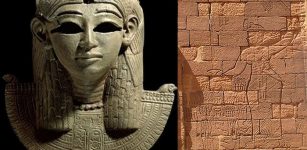Ancient Egyptians Played Bowling 5,000 Years Ago
A. Sutherland - AncientPages.com - Bowling can be traced to ancient Egypt. It was a popular game practiced in ancient Egypt about 5,000 years ago. Ancient Egyptians played a game in a large hall that was a cross between bowling and lawn balls. However, two people played at once, one at either end of a 4 meter long lane.
In the 1930's a British anthropologist, Sir Flinders Petrie, discovered all sorts of primitive bowling balls, bowling pins and other materials in the grave of an Egyptian boy from 3200 BC. It appears that the ancient Egyptians played a primitive form of bowling and that bowling is more than 5200 years old.
More recently, Professor Edda Bresciani, an Egyptologist at the University of Pisa and his team found evidence of an ancient Egyptian game that was a mixture of bowling, billiards and lawn bowls and was played at Narmoutheos, in the Fayoum region, some 90 kilometers south of Cairo. It was played in a spacious room that seems to be the prototype of a modern bowling hall.
The room was part of a structure, perhaps a residential building, which dated from the Roman period, specifically between the 2nd and 3rd century AD. Inside the room was a lane and two stone balls. The lane was about 4 metres long, 20 centimetres wide and 10 centimetres deep. And there was a 10 centrimetre square opening at its centre. the balls had different diameters; one fitted exactly the square opening, the other could run smoothly along the lane.

Ancient Egyptians played a bowls-like game as far back as 7200 BC, which spread across the Mediterranean,
evolving into Bocce in Italy, Petanque in France./Musée de la Boule/ Bowls Queensland
Ancient Egyptians played a bowls-like game as far back as 7200 BC, which spread across the Mediterranean,
evolving into Bocce in Italy, Petanque in France./Musée de la Boule/ Bowls Queensland
Bresciani says the game was played by two players positioned at the two ends of the lane. One would throw the smaller ball, the other the bigger one.
"They would throw the balls at the same time. Most likely, the bigger ball was thrown along the lane to prevent the smaller ball from entering the hole at the centre," Professor Edda Bresciani, said.
In France and Spain it is played with wooden or stone balls and is called 'boule' or 'petanque'.
It was introduced to Great Britain with the Norman Conquest, where its name loosely translated as 'throwing the stone'. Image via Bowls Queensland
"When this happened, the smaller ball could be easily recovered from the sand-filled terracotta vase below."
Each player took it in turns to throw the smaller ball, which determined the winner of the game. The winner was the player who was able to place the ball into the hole more times. Modern bowling is claimed to have roots in Germany around 300 A.D.

Bowling in Middle Ages. Philippe V and Charles V prohibit bowling games . Image credit: source
This is most likely where today’s pins were introduced. Parishioners were instructed to place their kegels, (a pin-resembling item that most Germans carried for protection and sport), at the end of a long lane. They then had to roll a rock at the kegel. If they knocked the kegel over, their sins were absolved. Martin Luther was an avid bowler, and set up a couple of lanes in his back yard so that he and his children could enjoy it as a sport.
Bowling was started in England in the early 1100’s. By the 1300’s there were several variations such as half-bowls, skittles, and ninepins. During the reign of King Henry VIII the game gained popularity and was played as a symbol of nobility and social status.
Written by – A. Sutherland - AncientPages.com Senior Staff Writer
Copyright © AncientPages.com All rights reserved. This material may not be published, broadcast, rewritten or redistributed in whole or part without the express written permission of AncientPages.com
Expand for referencesMore From Ancient Pages
-
 Amanirenas – Fearless Queen Of Kush Who Defeated Ancient Romans
Featured Stories | Jan 30, 2019
Amanirenas – Fearless Queen Of Kush Who Defeated Ancient Romans
Featured Stories | Jan 30, 2019 -
 Two Elite Burial Chambers Dated To Middle Kingdom Uncovered In Beni Hassan Necropolis, El-Minya, Egypt
Archaeology | Aug 6, 2018
Two Elite Burial Chambers Dated To Middle Kingdom Uncovered In Beni Hassan Necropolis, El-Minya, Egypt
Archaeology | Aug 6, 2018 -
 India’s Tradition Of Advanced Metallurgy, Craftsmen And Blacksmiths Is Longer Than Thought
Ancient Technology | Mar 19, 2019
India’s Tradition Of Advanced Metallurgy, Craftsmen And Blacksmiths Is Longer Than Thought
Ancient Technology | Mar 19, 2019 -
 The Mixtec – Mysterious Very Advanced Culture Of The Foremost Goldsmiths Of Mesoamerica
Civilizations | Dec 2, 2017
The Mixtec – Mysterious Very Advanced Culture Of The Foremost Goldsmiths Of Mesoamerica
Civilizations | Dec 2, 2017 -
 Ice Age People Returned To Central Europe Much Earlier Than Previously Thought
Archaeology | Jul 3, 2024
Ice Age People Returned To Central Europe Much Earlier Than Previously Thought
Archaeology | Jul 3, 2024 -
 Merneith: Mysterious Queen In The Land Of The Pharaohs Could Be Earliest Attested Female Ruler
Featured Stories | Mar 20, 2018
Merneith: Mysterious Queen In The Land Of The Pharaohs Could Be Earliest Attested Female Ruler
Featured Stories | Mar 20, 2018 -
 On This Day In History: Du Fu – ‘The Sage of Poetry’ Was Born – On Feb 12, 712
News | Feb 12, 2017
On This Day In History: Du Fu – ‘The Sage of Poetry’ Was Born – On Feb 12, 712
News | Feb 12, 2017 -
 Kava – Astonishing Ancient Plant That Improves Emotional Intelligence Is Gaining Popularity In The Western World
Featured Stories | Mar 31, 2018
Kava – Astonishing Ancient Plant That Improves Emotional Intelligence Is Gaining Popularity In The Western World
Featured Stories | Mar 31, 2018 -
 LIDAR Will ‘Map’ The Ground Surface To Reveal New Picture Of Ancient Native American Culture
Archaeology | Aug 18, 2023
LIDAR Will ‘Map’ The Ground Surface To Reveal New Picture Of Ancient Native American Culture
Archaeology | Aug 18, 2023 -
 Curious Ancient Prairie Mystery In Washington Scientists Cannot Solve – Maybe You Have An Idea What Happened?
Featured Stories | Nov 10, 2024
Curious Ancient Prairie Mystery In Washington Scientists Cannot Solve – Maybe You Have An Idea What Happened?
Featured Stories | Nov 10, 2024 -
 How The Handbook ‘Hammer Of Witches’ And Then-Existing Networks Inspired Europe’s Witch Craze
Social Sciences | Oct 10, 2024
How The Handbook ‘Hammer Of Witches’ And Then-Existing Networks Inspired Europe’s Witch Craze
Social Sciences | Oct 10, 2024 -
 Fascinating Discovery – First Female Viking Grave Discovered In Swedish Mountains
Archaeology | Aug 20, 2022
Fascinating Discovery – First Female Viking Grave Discovered In Swedish Mountains
Archaeology | Aug 20, 2022 -
 6,000-Year-Old Submerged Settlement Shows Black Sea Level Was Lower 5,000 Years Ago – ‘Black Sea Deluge’ Theory?
News | Nov 30, 2020
6,000-Year-Old Submerged Settlement Shows Black Sea Level Was Lower 5,000 Years Ago – ‘Black Sea Deluge’ Theory?
News | Nov 30, 2020 -
 Knowledge Of Ancient Medicine Hidden In Undeciphered Egyptian Manuscripts
Archaeology | Aug 16, 2018
Knowledge Of Ancient Medicine Hidden In Undeciphered Egyptian Manuscripts
Archaeology | Aug 16, 2018 -
 ‘Little Foot’ Is An Entirely New Species Of Early Human – Researchers Say
Archaeology | Jan 3, 2019
‘Little Foot’ Is An Entirely New Species Of Early Human – Researchers Say
Archaeology | Jan 3, 2019 -
 10th Century Sculpture Of Sun God Surya Accidentally Found In Farmland In Andhra Pradesh
Archaeology | Nov 16, 2020
10th Century Sculpture Of Sun God Surya Accidentally Found In Farmland In Andhra Pradesh
Archaeology | Nov 16, 2020 -
 Countless Artifacts, Structures And Roads Discovered In Ancient City Of Aigai, Turkey
Archaeology | May 16, 2022
Countless Artifacts, Structures And Roads Discovered In Ancient City Of Aigai, Turkey
Archaeology | May 16, 2022 -
 Travel Back To Ancient Greece In Virtual Reality
Archaeology | Jul 5, 2023
Travel Back To Ancient Greece In Virtual Reality
Archaeology | Jul 5, 2023 -
 Extremely Brutal Conflicts Among Maya Broke Out Before Civilization’s Decline
Archaeology | Aug 8, 2019
Extremely Brutal Conflicts Among Maya Broke Out Before Civilization’s Decline
Archaeology | Aug 8, 2019 -
 Golden Secrets Of Lake Guatavita And The Muisca People Gave Rise To The El Dorado Myth
Featured Stories | Nov 12, 2019
Golden Secrets Of Lake Guatavita And The Muisca People Gave Rise To The El Dorado Myth
Featured Stories | Nov 12, 2019


